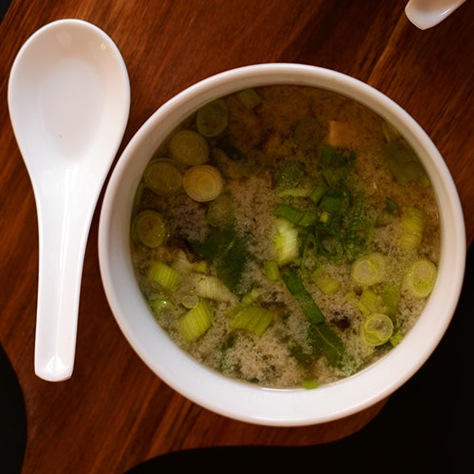Its super easy to make authentic Japanese miso soup at home! My recipe shows you how to make quick and easy soup stock (dashi) from scratch and then make the classic miso soup with tofu and wakame seaweed. Homemade miso soup is not only delicious, but it also brings many great health benefits.
Miso soup is a staple in Japanese cuisine and the Soup for the Soul. We enjoy it almost every single day, for breakfast, lunch, or dinner. As a Japanese home cook, I would also say that miso soup is probably one of the easiest soups you can make at home.
There are many paths to making miso soup, but once you know the basics, you will be able to branch out and customize. The goal of this post is to arm you with all the important knowledge so you can make yourself a bowl of authentic miso soup at home any time of the day. And trust me, what you make will taste 10,000 times better than the Japanese restaurants or the instant ones.
Most Japanese meals are served with a small bowl of steamed rice and a traditional Japanese soup called Miso Soup (味噌汁). At its most basic, miso soup is simply made of 3 components:
Depending on the region, season, and personal preference, you can find many varieties of miso soup enjoyed in Japan. In addition to the classic tofu and wakame combination that I show you today, we also use different savory ingredients such as veggies, meat, and seafood to make the soup. Thats why we can never get bored with it.

Homemade Miso Soup with Tofu

It’s super easy to make authentic Japanese miso soup at home! My recipe shows you how to make quick and easy soup stock (dashi) from scratch and then make the classic miso soup with tofu and wakame seaweed. Homemade miso soup is not only delicious, it also brings many great health benefits.
Prep: 5min
Total: 20min
Serving Size: 1 serving
Nutrition Facts: calories 57 kcal, Carbohydrate 5 g, Protein 4 g, Fat 2 g, Saturated Fat 0.3 g, Sodium 532 mg, Fiber 1 g, Sugar 2 g, unSaturated Fat 1.4 g, servingSize 1 serving
Ingredients:
- 4 cups water
- 1 piece kombu (dried kelp) ((⅓ oz, 10 g; 4 inches x 4 inches or 10 cm x 10 cm))
- 1 cup katsuobushi (dried bonito flakes) ((packed; I used a loosely packed 3 cups in the video for stronger flavor))
- 7 oz soft/silken tofu (kinugoshi dofu)
- 4-5 Tbsp miso ((1 Tbsp (18 g) for every 1 cup (240 ml) of dashi))
- 1 Tbsp dried wakame seaweed
- 1 green onion/scallion
Instruction:
- {‘@type’: ‘HowToStep’, ‘text’: ‘Gather all the ingredients.’, ‘name’: ‘Gather all the ingredients.’, ‘url’: ‘https://www.justonecookbook.com/?p=143752#wprm-recipe-58094-step-0-0’, ‘image’: ‘https://www.justonecookbook.com/wp-content/uploads/2022/06/Miso-Soup-Ingredients.jpg’}
- {‘@type’: ‘HowToStep’, ‘text’: ‘Cut the green onion into thin rounds.’, ‘name’: ‘Cut the green onion into thin rounds.’, ‘url’: ‘https://www.justonecookbook.com/?p=143752#wprm-recipe-58094-step-0-1’, ‘image’: ‘https://www.justonecookbook.com/wp-content/uploads/2022/06/Miso-Soup-10.jpg’}
- {‘@type’: ‘HowToSection’, ‘name’: ‘To Make the Dashi (Can Be Made in Advance)’, ‘itemListElement’: [{‘@type’: ‘HowToStep’, ‘text’: ‘Add the water and kombu to a medium saucepan. If you have time, soak the kombu in water for 30 minutes.xa0NEVER wash kombu and do not remove the white substance—that’s umami! These days, it’s pretty clean so just make sure there are no dirt particles.’, ‘name’: ‘Add the water and kombu to a medium saucepan. If you have time, soak the kombu in water for 30 minutes.xa0NEVER wash kombu and do not remove the white substance—that’s umami! These days, it’s pretty clean so just make sure there are no dirt particles.’, ‘url’: ‘https://www.justonecookbook.com/?p=143752#wprm-recipe-58094-step-1-0’, ‘image’: ‘https://www.justonecookbook.com/wp-content/uploads/2022/06/Miso-Soup-1.jpg’}, {‘@type’: ‘HowToStep’, ‘text’: ‘SLOWLY bring it to a boil on medium-low heat so you can extract as much umami from the kombu as possible (about 10 minutes). Right before the stock boils, remove the kombu and set it aside for another use. (If you leave the kombu, it gets slimy and yields a bitter taste.) Now, what you have isxa0Kombu Dashi. If you’rexa0vegetarian/vegan, use this kombu dashi for your miso soup.’, ‘name’: ‘SLOWLY bring it to a boil on medium-low heat so you can extract as much umami from the kombu as possible (about 10 minutes). Right before the stock boils, remove the kombu and set it aside for another use. (If you leave the kombu, it gets slimy and yields a bitter taste.) Now, what you have isxa0Kombu Dashi. If you’rexa0vegetarian/vegan, use this kombu dashi for your miso soup.’, ‘url’: ‘https://www.justonecookbook.com/?p=143752#wprm-recipe-58094-step-1-1’, ‘image’: ‘https://www.justonecookbook.com/wp-content/uploads/2022/06/Miso-Soup-2.jpg’}, {‘@type’: ‘HowToStep’, ‘text’: ‘If you’re not vegetarian/vegan, add thexa0katsuobushixa0to the kombu dashi and bring it back to a boil again. Once the dashi is boiling, reduce the heat, simmer for just 30 seconds.’, ‘name’: ‘If you’re not vegetarian/vegan, add thexa0katsuobushixa0to the kombu dashi and bring it back to a boil again. Once the dashi is boiling, reduce the heat, simmer for just 30 seconds.’, ‘url’: ‘https://www.justonecookbook.com/?p=143752#wprm-recipe-58094-step-1-2’, ‘image’: ‘https://www.justonecookbook.com/wp-content/uploads/2022/06/Miso-Soup-3.jpg’}, {‘@type’: ‘HowToStep’, ‘text’: ‘Turn off the heat and let the katsuobushi sink to the bottom, about 10 minutes. Then, strain through a fine-mesh sieve.’, ‘name’: ‘Turn off the heat and let the katsuobushi sink to the bottom, about 10 minutes. Then, strain through a fine-mesh sieve.’, ‘url’: ‘https://www.justonecookbook.com/?p=143752#wprm-recipe-58094-step-1-3’, ‘image’: ‘https://www.justonecookbook.com/wp-content/uploads/2022/06/Miso-Soup-4.jpg’}, {‘@type’: ‘HowToStep’, ‘text’: ‘Now you have roughly 4 cups ofxa0Awase Dashi. You can store the dashi in the refrigerator for up toxa03-5 daysxa0and in the freezer for up to 2 weeks. Reserve the spent katsuobushi and repurpose it; see the suggested recipes that follow at the end of the instructions.’, ‘name’: ‘Now you have roughly 4 cups ofxa0Awase Dashi. You can store the dashi in the refrigerator for up toxa03-5 daysxa0and in the freezer for up to 2 weeks. Reserve the spent katsuobushi and repurpose it; see the suggested recipes that follow at the end of the instructions.’, ‘url’: ‘https://www.justonecookbook.com/?p=143752#wprm-recipe-58094-step-1-4’, ‘image’: ‘https://www.justonecookbook.com/wp-content/uploads/2022/06/Miso-Soup-5.jpg’}]}
- {‘@type’: ‘HowToSection’, ‘name’: ‘To Make the Miso Soup’, ‘itemListElement’: [{‘@type’: ‘HowToStep’, ‘text’: ‘Add the dashi to the saucepan. If you are using premade dashi, bring it to simmer over medium heat and turn off the heat.’, ‘name’: ‘Add the dashi to the saucepan. If you are using premade dashi, bring it to simmer over medium heat and turn off the heat.’, ‘url’: ‘https://www.justonecookbook.com/?p=143752#wprm-recipe-58094-step-2-0’, ‘image’: ‘https://www.justonecookbook.com/wp-content/uploads/2022/06/Miso-Soup-6.jpg’}, {‘@type’: ‘HowToStep’, ‘text’: ‘Add the miso (typically,xa0use 1 Tbsp miso for every 1 cup (240 ml) of dashi). Put the miso in a ladle, slowly add the dashi into the ladle, and stir with chopsticks to dissolve the miso completely. Here, I’m usingxa0a miso muddler. If you accidentally add too much miso, dilute the miso soup with dashi (or water).xa0’, ‘name’: ‘Add the miso (typically,xa0use 1 Tbsp miso for every 1 cup (240 ml) of dashi). Put the miso in a ladle, slowly add the dashi into the ladle, and stir with chopsticks to dissolve the miso completely. Here, I’m usingxa0a miso muddler. If you accidentally add too much miso, dilute the miso soup with dashi (or water).xa0’, ‘url’: ‘https://www.justonecookbook.com/?p=143752#wprm-recipe-58094-step-2-1’, ‘image’: ‘https://www.justonecookbook.com/wp-content/uploads/2022/06/Miso-Soup-7.jpg’}, {‘@type’: ‘HowToStep’, ‘text’: ‘Here, I’m usingxa0a fine-mesh miso strainer,xa0which helps you dissolve the miso faster.xa0After dissolving the miso in the strainer, you may see rice koji (especially when it’sxa0koji miso). It’s up to you if you want to include it in the miso soup or discard it (personal preference).’, ‘name’: ‘Here, I’m usingxa0a fine-mesh miso strainer,xa0which helps you dissolve the miso faster.xa0After dissolving the miso in the strainer, you may see rice koji (especially when it’sxa0koji miso). It’s up to you if you want to include it in the miso soup or discard it (personal preference).’, ‘url’: ‘https://www.justonecookbook.com/?p=143752#wprm-recipe-58094-step-2-2’, ‘image’: ‘https://www.justonecookbook.com/wp-content/uploads/2022/06/Miso-Soup-8.jpg’}, {‘@type’: ‘HowToStep’, ‘text’: ‘Cut thexa0tofu into ½-inch (1.3 cm) cubes and add to the miso soup. Tip: Add the tofu after the miso is completely dissolved; otherwise, you might break the tofu when stirring in the miso. Note: It is very common to cut tofu on your palm in Japan. However, it’s not required and I recommend using a cutting board if you have never done this.’, ‘name’: ‘Cut thexa0tofu into ½-inch (1.3 cm) cubes and add to the miso soup. Tip: Add the tofu after the miso is completely dissolved; otherwise, you might break the tofu when stirring in the miso. Note: It is very common to cut tofu on your palm in Japan. However, it’s not required and I recommend using a cutting board if you have never done this.’, ‘url’: ‘https://www.justonecookbook.com/?p=143752#wprm-recipe-58094-step-2-3’, ‘image’: ‘https://www.justonecookbook.com/wp-content/uploads/2022/06/Miso-Soup-9.jpg’}, {‘@type’: ‘HowToStep’, ‘text’: ‘Add the dried wakame seaweed. Reheat the miso soup until it is just hot.xa0NEVER BOILxa0miso soup because it loses nutrients, flavor, and aroma. Add the chopped green onions right before serving to keep their fresh fragrance and color.xa0Tip:xa0If you worry about salt intake, I recommend rehydrating the dried wakame in a separate bowl of water to get rid of the saltiness, instead of rehydrating it in the soup itself.’, ‘name’: ‘Add the dried wakame seaweed. Reheat the miso soup until it is just hot.xa0NEVER BOILxa0miso soup because it loses nutrients, flavor, and aroma. Add the chopped green onions right before serving to keep their fresh fragrance and color.xa0Tip:xa0If you worry about salt intake, I recommend rehydrating the dried wakame in a separate bowl of water to get rid of the saltiness, instead of rehydrating it in the soup itself.’, ‘url’: ‘https://www.justonecookbook.com/?p=143752#wprm-recipe-58094-step-2-4’, ‘image’: ‘https://www.justonecookbook.com/wp-content/uploads/2022/06/Miso-Soup-11.jpg’}]}
- {‘@type’: ‘HowToSection’, ‘name’: ‘To Serve’, ‘itemListElement’: [{‘@type’: ‘HowToStep’, ‘text’: ‘Serve immediately. Place on the right side of the table setting (read about this onxa0Ichiju Sansai (One Soup Three Dishes)).’, ‘name’: ‘Serve immediately. Place on the right side of the table setting (read about this onxa0Ichiju Sansai (One Soup Three Dishes)).’, ‘url’: ‘https://www.justonecookbook.com/?p=143752#wprm-recipe-58094-step-3-0’, ‘image’: ‘https://www.justonecookbook.com/wp-content/uploads/2022/06/Miso-Soup-12.jpg’}]}
- {‘@type’: ‘HowToSection’, ‘name’: ‘To Store’, ‘itemListElement’: [{‘@type’: ‘HowToStep’, ‘text’: ‘In general, it’s best to consume all the miso soup right away because it will lose its aroma and taste as time passes. Let your miso soup cool to room temperature (up to 4 hours; any longer and it will spoil) and then refrigerate. Keep for up to 2 days in the refrigerator. If you want to make a big batch to store for later, it’s best to refrigerate the soup without adding the miso. When ready to use, add the miso only for the portion you need. You can freeze miso soup for up to 2 weeks. However, you have to remove the tofu before freezing as the texture will change.’, ‘name’: ‘In general, it’s best to consume all the miso soup right away because it will lose its aroma and taste as time passes. Let your miso soup cool to room temperature (up to 4 hours; any longer and it will spoil) and then refrigerate. Keep for up to 2 days in the refrigerator. If you want to make a big batch to store for later, it’s best to refrigerate the soup without adding the miso. When ready to use, add the miso only for the portion you need. You can freeze miso soup for up to 2 weeks. However, you have to remove the tofu before freezing as the texture will change.’, ‘url’: ‘https://www.justonecookbook.com/?p=143752#wprm-recipe-58094-step-4-0’}]}
- {‘@type’: ‘HowToSection’, ‘name’: ‘To Reheat the Miso Soup’, ‘itemListElement’: [{‘@type’: ‘HowToStep’, ‘text’: ‘Heat the miso soup in a pot over medium heat, but do not boil. Miso loses its nutrients, flavor, and aroma at high temperatures.’, ‘name’: ‘Heat the miso soup in a pot over medium heat, but do not boil. Miso loses its nutrients, flavor, and aroma at high temperatures.’, ‘url’: ‘https://www.justonecookbook.com/?p=143752#wprm-recipe-58094-step-5-0’}]}
- {‘@type’: ‘HowToSection’, ‘name’: ‘What to do with the spent katsuobushi and kombu?’, ‘itemListElement’: [{‘@type’: ‘HowToStep’, ‘text’: ‘Save the spent kombu and katsuobushi in an airtight container and store it in the refrigerator for a week or in the freezer for up to a month.’, ‘name’: ‘Save the spent kombu and katsuobushi in an airtight container and store it in the refrigerator for a week or in the freezer for up to a month.’, ‘url’: ‘https://www.justonecookbook.com/?p=143752#wprm-recipe-58094-step-6-0’, ‘image’: ‘https://www.justonecookbook.com/wp-content/uploads/2022/11/Furikake-step-by-step-37.jpg’}, {‘@type’: ‘HowToStep’, ‘text’: ‘With the spent kombu, you can makexa0Simmered Kombu (Kombu Tsukudani).’, ‘name’: ‘With the spent kombu, you can makexa0Simmered Kombu (Kombu Tsukudani).’, ‘url’: ‘https://www.justonecookbook.com/?p=143752#wprm-recipe-58094-step-6-1’, ‘image’: ‘https://www.justonecookbook.com/wp-content/uploads/2019/05/Kombu-Tsukudani-I-1.jpg’}, {‘@type’: ‘HowToStep’, ‘text’: ‘You can also makexa0Homemade Furikake (Rice Seasoning).’, ‘name’: ‘You can also makexa0Homemade Furikake (Rice Seasoning).’, ‘url’: ‘https://www.justonecookbook.com/?p=143752#wprm-recipe-58094-step-6-2’, ‘image’: ‘https://www.justonecookbook.com/wp-content/uploads/2022/11/Furikake-1393.jpg’}]}
15-Minute Miso Soup with Greens and Tofu

An inspired take on Japanese miso soup with tofu, green onion, and loads of greens. Just 15 minutes from start to finish, and so flavorful and comforting.
Prep: 5min
Total: 15min
Yield: 2
Serving Size: 1 bowls
Nutrition Facts: servingSize 1 bowls, calories 170 kcal, Carbohydrate 22.3 g, Protein 13.6 g, Fat 5 g, Saturated Fat 0.7 g, Sodium 1817 mg, Fiber 10 g, Sugar 9 g
Ingredients:
- 4 cups vegetable broth ((use dashi for more traditional miso soup // see notes above))
- 1 sheet nori ((dried seaweed // optional // cut into large rectangles // 1 sheet yields 1/4 cup))
- 3-4 Tbsp white or yellow miso paste
- 1/2 cup chopped green chard or other sturdy green
- 1/2 cup chopped green onion
- 1/4 cup firm tofu ((cubed // use silken tofu for more traditional miso soup))
Instruction:
- Place vegetable broth in a medium sauce pan and bring to a low simmer.
- In the meantime, place miso (starting with lesser end of range) into a small bowl, add a little hot water and whisk until smooth. This will ensure it doesn’t clump when added to the soup later. Set aside.
- To the broth add chard (or other greens of choice), green onion, and tofu (if using silken, add at the end of cooking) and cook for 5 minutes. Then add nori and stir. Remove from heat, add miso mixture, and stir to combine.
- Taste and add more miso or a pinch of sea salt if desired. Serve warm. Best when fresh.
Miso Soup

Learn how to make miso soup at home! We love serving this nourishing, savory soup with shiitake maki for a fun, at-home sushi night.
Prep: 10min
Ingredients:
- 1 (3-inch) piece of kombu
- 4 cups water
- 3 tablespoons wakame dried seaweed
- ¼ cup white miso paste
- ⅓ cup chopped scallions
- 6 ounces silken tofu (cubed)
- tamari (to taste)
Instruction:
- Gently rinse the kombu piece. Place it in a medium pot with the water and gently simmer for 10 minutes. Don’t let it boil, or the kombu flavor will turn bitter.
- Soak the wakame in a small bowl of warm water for at least 5 minutes to rehydrate.
- Remove the kombu from the soup. In a small bowl, stir the miso paste together with some of the hot broth until the mixture is smooth, then stir it back into the soup.
- Drain the wakame and add it to the soup pot along with the scallions and tofu. Simmer over very low heat for 1 to 2 minutes. Season, to taste, with tamari.
Easy Miso Soup

A super simple, hearty miso soup that can be made from pantry ingredients. In our experience, it also makes a great cold remedy!
Prep: 10min
Total: 20min
Serving Size: 1 serving
Nutrition Facts: calories 131 kcal, Carbohydrate 8 g, Protein 11 g, Fat 6 g, Saturated Fat 2 g, Trans Fat 0.01 g, Cholesterol 123 mg, Sodium 759 mg, Fiber 1 g, Sugar 2 g, unSaturated Fat 4 g, servingSize 1 serving
Ingredients:
- 8 cups water
- 4 tablespoons white miso paste
- 1 tablespoon chicken bouillon paste
- 1/2 teaspoon dashi powder ((we use Ajinomoto Hon Dashi granules))
- 12-16 ounces silken tofu
- 1 scallion
- 3 eggs
- 3 tablespoons dried wakame seaweed
Instruction:
- Add the water to a medium pot, cover, and set over high heat. Meanwhile, gather your ingredients. Add the miso paste, chicken bouillon paste, and Hondashi powder to the pot. Bring to a boil.
- While the broth cooks, cut your tofu into cubes. (½-inch/1cm cubes are a good place to start, but cut them however you like!)
- Give the broth a stir to make sure the miso is evenly distributed. Add the tofu, and simmer for another 5 minutes or so.
- While that’s happening, chop the scallions. (If you’re like us, and you have some already chopped and frozen, you can skip this step.) Lightly beat the eggs in a small bowl. Add the wakame seaweed.
- With the soup at a low simmer, pour in the egg in a circular pattern. Don’t stir the soup, and don’t let it come up to a high simmer/boil. Add the scallions, give everything a stir, and serve!
The Easiest Miso Soup Recipe Ever!
FAQ
What is traditional miso soup made of?
Is miso soup actually good for you?
Is it OK to drink miso soup everyday?
Is miso anti inflammatory?
